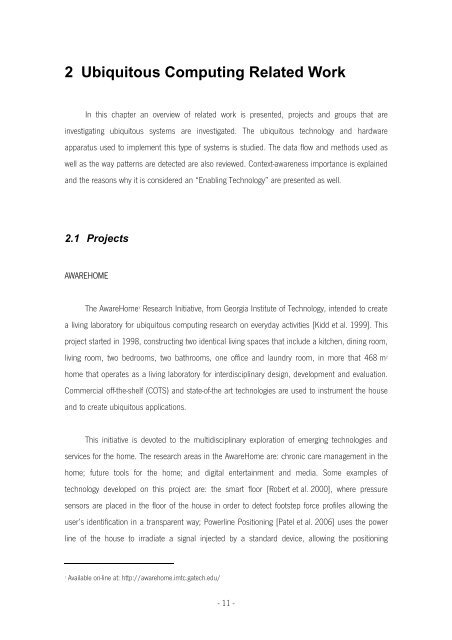Carlos Manuel Rodrigues Machado Autonomic Ubiquitous Computing
Carlos Manuel Rodrigues Machado Autonomic Ubiquitous Computing
Carlos Manuel Rodrigues Machado Autonomic Ubiquitous Computing
Erfolgreiche ePaper selbst erstellen
Machen Sie aus Ihren PDF Publikationen ein blätterbares Flipbook mit unserer einzigartigen Google optimierten e-Paper Software.
2 <strong>Ubiquitous</strong> <strong>Computing</strong> Related Work<br />
In this chapter an overview of related work is presented, projects and groups that are<br />
investigating ubiquitous systems are investigated. The ubiquitous technology and hardware<br />
apparatus used to implement this type of systems is studied. The data flow and methods used as<br />
well as the way patterns are detected are also reviewed. Context-awareness importance is explained<br />
and the reasons why it is considered an “Enabling Technology” are presented as well.<br />
2.1 Projects<br />
AWAREHOME<br />
The AwareHome 1 Research Initiative, from Georgia Institute of Technology, intended to create<br />
a living laboratory for ubiquitous computing research on everyday activities [Kidd et al. 1999]. This<br />
project started in 1998, constructing two identical living spaces that include a kitchen, dining room,<br />
living room, two bedrooms, two bathrooms, one office and laundry room, in more that 468 m 2<br />
home that operates as a living laboratory for interdisciplinary design, development and evaluation.<br />
Commercial off-the-shelf (COTS) and state-of-the art technologies are used to instrument the house<br />
and to create ubiquitous applications.<br />
This initiative is devoted to the multidisciplinary exploration of emerging technologies and<br />
services for the home. The research areas in the AwareHome are: chronic care management in the<br />
home; future tools for the home; and digital entertainment and media. Some examples of<br />
technology developed on this project are: the smart floor [Robert et al. 2000], where pressure<br />
sensors are placed in the floor of the house in order to detect footstep force profiles allowing the<br />
user’s identification in a transparent way; Powerline Positioning [Patel et al. 2006] uses the power<br />
line of the house to irradiate a signal injected by a standard device, allowing the positioning<br />
1 Available on-line at: http://awarehome.imtc.gatech.edu/<br />
- 11 -

















